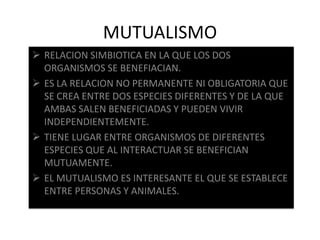
Mutualismo
- 1. MUTUALISMO RELACION SIMBIOTICA EN LA QUE LOS DOS ORGANISMOS SE BENEFIACIAN. ES LA RELACION NO PERMANENTE NI OBLIGATORIA QUE SE CREA ENTRE DOS ESPECIES DIFERENTES Y DE LA QUE AMBAS SALEN BENEFICIADAS Y PUEDEN VIVIR INDEPENDIENTEMENTE. TIENE LUGAR ENTRE ORGANISMOS DE DIFERENTES ESPECIES QUE AL INTERACTUAR SE BENEFICIAN MUTUAMENTE. EL MUTUALISMO ES INTERESANTE EL QUE SE ESTABLECE ENTRE PERSONAS Y ANIMALES.
- 3. MUTUALISMO FACULTATIVO • ESTE TIPO DE MUTUALISMO LOS ORGANISMOS PARTICIPANTES PUEDEN VIVIR EN AUSENCIA UNO DEL OTRO.
- 5. MUTUALISMO OBLIGADO • ESTE TIPO DE MUTUALISMO SE PRESENTAN CUANDO DOS ORGANISMOS NECESITAN IRREMEDIABLEMENTE DE LA PRESENCIA DEL OTRO PARA SUBSISTIR. (UN EJEMPLO LAS TERMITAS Y LOS PROTOZOARIOS)
- 7. LOS PROTOZOARIOS EJEMPLO: MUTUALISMO OBLIGADO. • VIVEN EN EL APARATO DIGESTIVO DE LAS TERMITAS, QUE DESCOMPONEN LA MADERA QUE ESTAS CONSUMEN. LAS TERMITAS NO PUEDEN VIVIR SIN ESTOS PROTOZOARIOS Y LOS PROTOZOARIOS NO PUEDEN VIVIR SIN LAS TERMITAS PUES ESTAS SON SU HABITAT.
- 8. EL MUTUALISMO NO ES DE TIPO ALTRUISTA YA QUE UNA ESPECIE NO ACTUA EN BENEFICIO DE LA OTRA • CADA ORGANISMO ACTÚA EN SU PROPIO BENEFICIO Y LA INTERACION SE MANTIENE GRACIAS A QUE LOS DOS SE MANTIENEN BENEFICIADOS. • EN MUCHAS RELACIONES MUTUALISTAS UN ORGANISMO BRINDA ALIMENTO AL OTRO Y EL SEGUNDO OFRECE AL PRIMERO PROTECCION, LIMPIEZA, DISPERSIÓN, POLINIZACIÓN O SIMPLEMENTE UN SITIO PARA VIVIR.
- 9. EXISTEN MUCHOS EJEMPLOS DE MUTUALISMO. EL PEZ PAYASO QUE VIVE EN ASOCIACION CON ANEMONAS QUE TIENEN CELULAS URTICANTES QUE DAÑAN A OTROS PECES, EL PEZ PAYASO SE ESCONDE ENTRE LOS TENTACULOS DE LA ANEMONA SIN SUFRIR DAÑO ALGUNO ASI EL PEZ VIVE ENTRE LOS TENTACULOS. EL TIBURON Y LAS REMORAS, ESTAS ULTIMAS SE ALIMENTAN DE LOS ECTOPARASITOS QUE SE ENCUENTRAN EN EL CUERPO DEL TIBURON Y OFRECE PROTECCION A LAS REMORAS DE LOS DEPREDADORES.
- 12. LA RELACION QUE SE DA ENTRE LAS PLANTAS CON FLORES Y SUS ORGANISMOS POLINIZADORES ES UN MUTUALISMO. LA PLANTA OFRECE EL NECTAR Y EL POLEN DE SUS FLORES, QUE EL POLINIZADOR COLECTA Y CONSUME COMO ALIMENTO. EL POLINIZADOR TRASPORTA EL POLEN DE LA PLANTA A OTRAS FLORES Y ASI PRODUCEN SEMILLAS. (ABEJORROS, ABEJAS Y AVISPAS), LEPIDOPTEROS (MARIPOSAS Y PALOMILLAS) Y DIPTEROS (MOSCAS) ASI COMO COLIBRIS Y ALGUNOS MURCIELAGOS.
- 14. EN ASOCIACIONES ENTRE PARES DE ESPECIES CON BENEFIECIOS MUTUOS LAS ESPECIES TIENEN UNA TASA DE CRECIMIENTO SUPERIOR CUANDO CONVIVEN Y OFRECEN UNA SERIE DE VENTAJAS DIFERENTES. 1. ALIMENTO PARA UNO DE ELLOS 2. PROTECCION 3. SERVICIO (LIMPIEZA DE PARASITOS, POLINIZA) UNA ESPECIE VIVE EN LA SUPERFICIE O CAVIDAD DEL OTRO. UNA ESPECIE VIVE EN EL INTERIOR DE LAS CELULAS DE OTRO.
- 20. Gracias por su atención